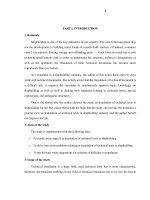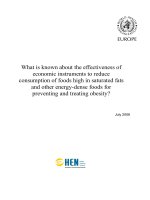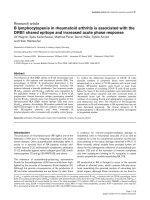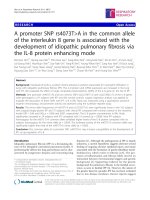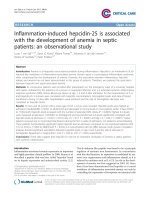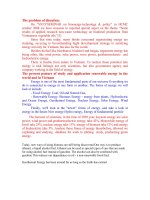Translation of technical texts in shipbuilding
Bạn đang xem bản rút gọn của tài liệu. Xem và tải ngay bản đầy đủ của tài liệu tại đây (416.23 KB, 42 trang )
PART I: INTRODUCTION
1. Rationale
Shipbuilding is one of the key industries of our country. The next following years may see
the development in building many kinds of vessels: bulk carriers, oil tankers, container vessel,
car carriers, floating storage and offloading units …. Each kind of vessel has it own technical
specification. And in order to understand the structure, technical characteristic as well as the
operation, the translation of these technical documents has become more importantly than ever
before.
As a translator in a shipbuilding company, the author of this minor thesis days by days
work with technical documents. She is fully aware that the translation of technical document is a
difficult job, it requires the translator to continuously improve basic knowledge on shipbuilding
as well as skill in dealing with situations relating to technical terms, special expressions, and
ambiguous structures…
That is the reason why the author chooses the study on translation of technical texts in
shipbuilding for her MA minor thesis with the hope that the study can provide the translator a
general view on translation of technical texts in shipbuilding industry and the author herself can
improve her job.
2. Aims of the study
The study is implemented with the following aims:
o To clarify some aspects in translation of technical texts in shipbuilding
o To delve into some problems relating to translation of technical texts in shipbuilding
o To put forward some suggestions for solution of difficulty in translation
3. Scope of the study
Technical translation is a huge field, each technical field has it owns characteristic,
therefore, the translator working on any field of technical translation has to try her/ his best to
1
fulfill her/ his job. The translation of technical texts in shipbuilding is not an exception. Within
the scope of this study, a study on the translation of technical texts in shipbuilding is very
exclusive to talk about. However, due to the limitation of time and lack of experience, my minor
thesis is only limited to dealing with some aspects, problems in translating technical text in
shipbuilding.
4. Method of the study
To set up the framework for this study, the author refers to some in-house and foreign
publications. In order to achieve the goal of the study, the main method is quantitative data
analysis. All the considerations, conclusions in this minor thesis are largely based on:
o Reference to relevant publications
o Analysis of collected data
o Personal observations
5. Design of the study
The study consists of three parts:
Part 1, introduction, includes: rationale, aims, scope, method and design of the study. Part
2 is the development, the focus of the study with three chapters: Chapter 1 is general theoretical
background, it introduces general information about translation theory. Chapter 2 deals with an
investigation into translation of technical text in shipbuilding. In this chapter, some kinds of
technical shipbuilding texts, aspects and problems related to translation these documents are
analyzed. Chapter 3 is the implication. This chapter points out some mistakes the translator often
meets in translating and some suggested solutions. Part 3 is the conclusion.
2
PART II: DEVELOPMENT
Chapter 1: Theoretical background
1. What is translation?
Translation has been the subject of interest not only to linguists, professional and amateur
translators, language teachers but also to other engineers of other technical fields. A great
number of publications have been written about this matter. However, “What is translation?” is
still a question in need of research.. Barkhudarov (1975) defined translation as “the
transformation of a speech product in one language into that of other language keeping the
content (or meaning) unchanged”, by speech product he meant translation as an act of
communication. Catford (1965) considers translation is an cognitive behavior by saying that
“Translation is the replacement if textual material in one language (source language) by
equivalent textual material in other language (target language)”. For Nida & Taber (1974),
translation “consists in reproducing in the receptor language the closet natural equivalent of the
source language message, first in terms of meaning and secondly in terms of style”. Hatim &
Mason (1990) termed it briefly “Translating is a communicative process which takes place
within a social context”.
Different scholars defines translation in different way, seemingly, they have not come up
with a “single valid comprehensive theory of translation”, that is because they seem to look at
translation from different views.
2. Text, discourse and translation
2.1. About text, discourse and translation
Text and discourse sometimes are confused in linguistic. For Windowson, a text is
“sentences in combination”, and discourse is the “use of utterances in combination”. To put it
more clearly, text is a “structured sequence of linguistic expressions forming a unitary whole”
and discourse is a “structured event manifest in linguistic (and other) behavior”. Yet, these
definitions do not satisfy because text and discourse sometimes are used interchangeably, and
text is referred to as “written documents” while discourse as “speech”. Thus, Roger (1991)
3
proposed the following: text is “the formal product of selections of options from the THEME
systems of the grammar; a unit which carries the semantic sense of the proposition (the
propositional content and locutionary force of the speech act) through sentences which are
linked by means of cohesion” and discourse is “ a communicative event which draws on the
meaning potential of the language (and other systems of communication) to carry
communicative value (the illocution force) of speech acts through utterances which are linked
by means of coherence”.
A text is a string of sentences, a unit of language in use. A discourse is a communicative
process by means of interaction and its linguistic product is text. And discourse refers to the
connected speech or writing at supra – sentential levels while text – both written and spoken – is
seen as the representation of discourse.
Discourse analysis is the analysis of language in use and includes in itself the analysis of
the text beyond and above the sentence. Thus, text is one of the core terms in translation.
2.2. Types of text
Type of text is an important factor in translation. It affects on all stages of translation and
translation product. That is the reason why that this matter is always discussed in translation.
According to Newmark (1988), one of the most important function of language is to help
the users to express their feelings, thus equivalent to expressive function of language, we have
expressive text. Imaginative, authoritative statements and autobiography, essays, personal
correspondence are some sub-types of this kind of text.
The very important function of language is informative function. For Newmark (1988),
“the core of the informative function of language is external situation, the facts of a topic, reality
outside language, including reported ideas or theories”. The informative text –type includes
scientific papers, textbooks, popular science or art books, popular journalism.
The third function of language, as Newmark (1988) proposes is to call upon the readership
to act, think or feel in order to react in the way intended by the text, say, vocative text. This text
4
– type is also called instrumental, operative text aiming at producing a certain effect on the
readership. This text type includes: instructions, publicity, propaganda, persuasive writing.
Besides, Newmark also bases on 3 other functions of language which were proposed by
Jakobson to classify some other text – types: The aesthetic function – aesthetic text, the phatic
function – phatic text, the metalingual function – metalingual text.
2.3. Text analysis in translation
Text analysis plays an important role in translation process, thus, it is always paid attention
by both the translator and the translation researcher. According to Newmark (1988), analysis of
a text is a procedure in which the translator must read the text, find out the intention of the text,
text styles, readership, as well as stylistic scales, attitude, setting. Besides, the translator has to
take into account the quality of the writing, and before translating, he/ she has to read the text
the last time.
2.3.1. Reading the text
The translator, at first, is the reader, but not the normal reader. At least, he is both reader
and reader – translator. As Newmark (1988) claimed, the translator begins the job by reading for
two purposes: “to understand what it is a bout; to analyze it from the translator’s point of view”.
The translator has to define its intention and the way it is written for the purpose of selecting
suitable translation method and identifying particular problems.
Also, Newmark (1988) suggested in order to understand the text, general reading and close
reading are required. General reading is “to get the gist”. The translator can gather general
information about subject of the text through textbooks, specialist papers. Close reading is to
read “words both out of and in the context”.
2.3.2. The intention of the text and the intention of the translator
In reading, the translator, as Newmark (1988) stated, searches for the intention of the text,
he/ she can not isolate this from understanding it. Intention of the text is shown through the
selecting means like grammatical structures, vocabulary of the writer, for example: two texts
describe the same subject as a battle for instance, the positive text uses positive expressions,
5
vocabulary such as hopefully, luckily…. However, the negative text, conversely, uses negative
expressions, vocabulary like unfortunately, it is a pity that…. “The intention of the text
represents the SL writer’s attitude to the subject matter” (Newmark (1988)). Thus, the first and
very important task is to search the intention of the text.
And, also according to Newmark (1988) “usually, the translator’s intention is identical
with the intention of the source text author”. But sometimes, it is adapted by the translator to
make it suitable to new readership.
2.3.3. Text styles
Understanding text styles is an important step in analyzing text. According to Nida (1979),
four types of text are divided as per the text styles. The first is narrative text , it is a “dynamic
sequence of events”, and because it is a sequence of event, it is expressed by a string a verbal
actions. The second type is descriptive. This kind of text is, on the contrary, is “static with
emphasis on linking verbs, adjective, adjectival nouns”. The third type is discussion, it is “a
treatment of ideas, with emphasis on abstract nouns (concepts), verbs of thought, mental
activity, logical argument and connectives”. And the last type as Nida (1979) suggested is
dialogue with “emphasis on colloquialism and phaticisms”.
2.3.4. Readership
The readership is a group of readers that the text is aimed at and this group is marked with
level of education, the class, age and sex. In translation, as Newmark (1988) claimed, the
readership of SL text should be characterized, then the readership of the translation to decide
how much attention to pay to the TL readers.
And, Newmark (1988) states that there is a tendency to make the translation for “educated,
middle – class readership in an informal, colloquial style”..
There are three types of readership: expert, educated layman, and the uniformed.
2.3.5. Stylistic scales
To understand and form as suitable text, the translator has to identify the stylistic scales of
the text. For example, basing on the formality, texts can be divided: officialese, official, formal,
6
neutral, informal, colloquial, slang and taboo; basing on the generality and difficulty, texts can
be divided into: simple, popular, neutral, educated, technical and opaquely technical; and basing
on emotional tone: intense, warm, factual and understatement.
2.3.6. Setting of the text
To learn about the setting of the text, Newmark (1988) suggests is to find out the place
where the text will be published in TL, the TL equivalent of the SL periodical, newspaper,
textbook, .., the clients and their requirements, also take into account the “briefer title, absence
of sub-titles and sub-headings, shorter paragraphs, and other features of the TL house-style”.
The translator has to “make several assumptions” about the readership, that is to say, who
they are, their education….
2.3.7. The quality of the writing
Another important thing the translator has to pay attention is the quality of the writing in
order to choose the translation method. The quality of the writing, as Newmark (1988) claimed,
depends upon the author’s writing skill, author’s intention and the requirement of the subject
matter. A text is considered to be a well – written one when is uses the right words in right
places, it has a minimum of redundancy, it is logical, …. The authority of a text is subject to the
status of writer in his field. If the text is written by an experts, of course, the accuracy is better.
If the text is written with “stereotyped phrased, poorly written”, the translator at that time, has to
deal with the badly written text.
2.3.8. The last reading
At last, the translator should read the text, he/ she should underline “all neologism,
metaphors, cultural words and institutional terms, technical terms, proper names, and
“untranslatable” words” to identify the “semantic range, the frontiers”. This can be considered
to be the last analyzing step in translating process.
3. Translation method
For a good translator, which could be considered the utmost importance and the guideline
in translation job is translation methodology. It has been a central problems whether to translate
7
“literally or freely” at least since the first century BC. Many years have gone, some methods
have been identified and Newmark (1988) has put the argument in the form of a flattened V
diagram as the following:
Diagram 1: V diagram of translation method by Newmark (1988)
3.1. Word – for – word translation
Word – for – word translation is a method in which the words are translated “singly by
their most common meanings, out of context”, the method in which the “SL word – order is
preserved”. This method is used to understand the mechanics of source language and to attempt
to analyze preliminarily draft of translation process.
3.2. Literal translation
This kind of method is somehow similar to word – for – word translation in that “the
lexical words are again translated singly” except for one thing, that is, it lays focus on the
conversion of the SL grammatical construction into their nearest TL equivalents.
3.3. Faithful translation
This method reproduces the precise contextual meaning of the original and deals with the
constraints of the TL grammatical structures. Its aim is to be “completely faithful” to the
intentions and the text-realization of the SL writer.
8
3.4. Semantic translation
Semantic translation takes into account the aesthetic value – the beauty of the SL text. It is
more flexible than faithful translation in that it admits creative exception to 100% fidelity and
allows the translator’s intuitive empathy with the original.
3.5. Adaptations
For this type of translation, the SL culture is converted to TL culture and the text is re-
written by the experts in the field of the text content. It is used mainly for plays and poetry. It is
the “freest” form of translation.
3.6. Free translation
Free translation reproduces the manner without paying attention to the manner, it
expresses the content without the form of the original.
3.7. Idiomatic translation
This type of translation conveys the “message” of the original text. And with idiomatic
translation, nuances of meaning are transmitted to TL text by colloquialisms and idioms which
do not have in the original.
3.8. Communicative translation
Communicative translation presents the exact contextual meaning of the original in such a
way that both content and language are made to be acceptable and comprehensible to the readers
of TL language.
On analyzing the method of translation, it is experienced that communicative translation is
appreciated. However, depending on the text type, the translation method is chosen because with
this kind of text, this method is the best but it is not good for the others.
4. Equivalence in translation
Equivalence can be considered as a fundamental conception in translation and it is
mentioned in most of the definitions of translation, however, it is difficult to agree on a uniform
concept of equivalence. Thus, there exist many categories of equivalence: content equivalence,
9
stylistic equivalence, formal equivalence, functional equivalence, textual equivalence, dynamic
equivalence, communicative equivalence, pragmatic equivalence and equivalence of effect by
scholars like Winter (1961), Catford (1965), Nida & Taber (1969), Will (1977) and Jager
(1975).
And according to Newmark (1988), the utmost purpose of any translation is to reach
“equivalence effect”, that is to say, to create the same effect (or one as close as possible) on the
group of readers of translation and the readership of the original.
Within this minor thesis, the writer only considers some equivalence types which are the
most mentioned and are applied widely.
4.1. Quantity based equivalence
- One to one equivalence:
For this kind of equivalence, there is a single expression in TL for a single expression in
SL. This equivalence is commonly seen in terminology.
- One to many equivalence
There are many expressions in TL for a single SL expression in this kind of equivalence.
- One to part one equivalence
With this equivalence, one way of expression in SL has more than one meaning but the
way of expression in TL is only equivalent to one of the meanings.
- Nil – equivalence
There is no equivalence in TL due to difference in culture
4.2. Meaning – based equivalence
This kind of equivalence is considered by Koller (1979) as follows:
- Denotative equivalence
The equivalence in which both SL and TL expressions show the same definition, event in
real life.
- Connotative equivalence
This type of equivalence bases on connotation of language. It provides additional values
besides denotation value. This equivalence is formed by selecting words in different aspects
10
such as style, usage, social, usage frequency…. It can be connotation of poetry language,
connotation of socially determined usage, connotation of geographical relation or origin,
connotation of stylistic effect, connotation basing on evaluation, connotation basing on attitude
and connotation basing on register (the case of technical language).
For the author of this minor thesis, connotative equivalence basing on register is of great
interest and importance because her topic deals with the translation of technical text in
shipbuilding and the equivalence of technical text translation is based on connotative register.
- Text – normative equivalence
For this type of equivalence, the SL and TL expressions are used in the same or similar
context in their respective language like correspondence and law.
- Formal equivalence
The equivalence formed by form expression when both the SL and TL have the same
aesthetic feature which is created by formality. The equivalence is originated from rhyme, tune,
style of poetry, metaphor, …..
5. Technical translation
In modern world, science and technology are applied in every aspect of life, thus, the
number of scientific and technological texts appear in a great number. And the profession of
translator is co-extensive with the rise of technology, and staff translators working in that field
are usually called technical translators. But what is technical translation?
Newmark (1988) defines and distinguishes technical translator from institutional
translation “Technical translation is one part of specialized translation; institutional translation,
the area of politics, commerce, finance, government etc., is the other”. He also suggests that
technical translation is potentially non-cultural and universal because the benefits of technology
are not confined to one speech community. In his view, the technical terms should be translated,
whereas, the institutional translation is cultural so the terms are transferred.
Also, according to Newmark (1988), technical translation is primarily distinguished from
other forms of translation by terminology, its characteristics, grammatical features (passives,
11
nominalizations, third person, empty verbs, present tenses) and it technical format (technical
report).
5.1. Technical style
Newmark (1988) suggests “unless its non-technical language is jazzed up and
popularized, it is usually free from emotive language, connotations, sound-effects and original
metaphor, if it is well-written”. However, not all the technical texts are well – written, thus, it’s
the translator’s job to rephrase poorly written language.
Regarding to technical style, Parpcke (1975) distinguished four kinds of technical
language: scientific, workshop level, every day usage level, and publicity/ sales. Yet, according
to Newmark (1988), the division Parpcke is “likely to be valid only for one or two terms in a few
fields”. He suggests the following scales: academic, professional and popular.
5.2. Technical terms
Newmark (1988) states that “ Technical translation is primarily distinguished from other
forms of translation by terminology”. Thus, the core characteristic of a technical text in any field
is terms; terms are also the main factor to distinguish a technical text from other kinds of texts.
And, the central difficulty in technical translation is usually new terminology.
It is due to the fact that some technical terms appear only once in the source language and
the context is not clear to the translator. Furthermore, the technical terms are distilled knowledge
and written for specialists in that field.
It is also because that even standardized terms may have more than one meaning in one
specific field, as well as in the other fields.
5.3. Technical terms and descriptive terms
One matter in technical translation is to distinguish technical and descriptive terms.
According to Newmark (1988), the original SL writer may use a descriptive terms for a
technical object for three reasons:
o The object is new, and has not yet got a name
o The descriptive term is being used as a familiar alternative, to avoid repetition;
12
o The descriptive term is being used to make a contrast with another one.
Also, he suggests that technical terms and descriptive terms should be translated by their
counterparts, and the translator should resist the temptation of translating a descriptive terms by
a technical terms for the purpose of showing off his/ her knowledge. However, he points out that
if the SL descriptive term is being used either because of the SL writer’s ignorance, or because
the appropriate technical term does not exist in the SL, and if an object strange to the SL but not
to the TL culture is being referred to, the translator is justified in translating a descriptive term
by a technical term.
Further to technical and descriptive terms, Newmark (1988) claims it is a trend that
professional translators make “a mystique out of their craft” by denying any descriptive terms
where a TL technical term exists. He points out the reason that because technical terms are
standardized language and more precise (narrower in semantic range) whereas, descriptive terms
are non-standardized language.
5.4. Translation method
5.4.1. Beginning technical translation
Idiom says that “practice makes perfect”. Technical translation is similar. The more the
translator get practice, the better he/ she translates. However, the challenge or the difficult thing
for the technical translator is that the translator is not well – informed about the topic of the
technical text, is lack of knowledge about technicality. And as Newmark (1988) advises the
translator is “more interested in understanding the description, the function and the effect of a
concept such as entropy rather than in learning laws, particularly axioms, theorems, theories,
systems in some of which entropy is involved”. Or to put it more clearly, “to translate a text you
so not have to be an expert in its technology or its topic; but you have to understand that text
and temporarily know the vocabulary it uses”.
He suggests as a translator working in technical translation, when translating a text, the
translator has to be able to stand back and understand roughly what is happening in the real life
or he/ she has to convince himself/ herself that the sentence which has just been translated
13
makes sense. Although many technical terms can be translated “literally”, the translator has to
check the present validity with the register and dialect.
Thus, in order to begin a technical text, according to him, the translator should, at first,
read it to understand what the text is about (underline difficult words) and then assess its nature (
proportion of persuasion to information), its degree of formality, its intention (attitude to topic),
the possible cultural and professional differences between the readership and the original one.
Next, the translator should give the translation a framework of recognized house-style. The
translator has to take into account everything, every word, every figure, letter, every punctuation
mark…..
5.4.2. Translating the title
Newmark (1988) classifies title either is descriptive or allusive. According to him, a
descriptive title names the subject succinctly while allusive title is suitable for some imaginative
literature and popular journalism and may be changed.
The title states the subject but it does not always mention the purpose or intention of the
process which is described.
Besides, Newmark (1988) also states two other points of title. Firstly, the title of the SL
text is often two long by English standards. Secondly, the title has a transparent collocation.
And according to him, almost errors in technical translation are caused by misleading
adjective plus noun collocations for standardized terms. And for non-standardized terms, the
errors can be caused by transparent or motivated verb plus object, or subject plus verb
collocations.
5.4.3. Going through the text
It is suggested by Newmark (1988) that The translator, then, should read the text through
to get the gist of the main idea and underline all words and structures that appear to contain
problems: new technical terms, special expressions, syntactic ambiguity…. After that, the
translator can translate sentence by sentence, making grammatical shifts to for natural language.
14
In technical translation, the translator can be as bold and free in recasting grammar (cutting up
sentences, transposing clauses, converting verbs to nouns, etc.) as in any type of informative
text, provided the original is defective. Lexically, the main characteristic of technical language is
its actual richness and its potential infinity. The translator has to ensure the equivalent level of
register to TL (he/ she may separate new terms and compare to the context, sometimes actual
practice to deal with the meaning). And last, the translator has to adjust the translated sentence
as per the technical style.
15
Chapter 2: An investigation into translation of technical texts in shipbuilding
1. Text characteristic in shipbuilding
1.1. Kinds of texts
Texts, as many other fields, are the main way to connect the builder, the engineers and the
owner. Through the texts, all the necessary written information is transferred. Thus, they are
very important. And in shipbuilding, texts are shown in the followings types:
1.1.1. Specification
For the vessel, specification is the thing that introduces, describes the main particulars,
equipment as well as necessary related matters the vessels must have when going in service.
Outline specification of 260 TEU container vessel is an example.
General description
Type of ship Single crew, slow speed diesel engine driven container vessel with
bulbous bow, transom stern and five (5) box-shaped cargo holds for
transportation of container in holds with cell guides, and on deck with
lashing
Type of cargo Containers (TEUs and FEUs)
Classification NK or ABS
Navigation area Ocean going
Flag Singapore
1.1.2. Technical manual
This kind of document is the one, besides specification, that the supplier, the maker and
owner and builder get information about the operation of the equipment in the vessel. Without it,
we can not build a ship, we can not install or assemble any equipment.
16
